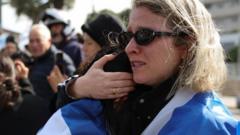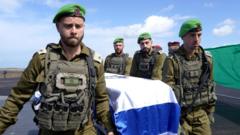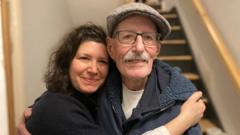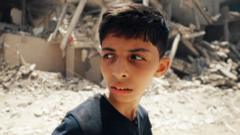The return of the deceased hostages has sparked waves of mourning and reflection in Israel, as families confront grief against the backdrop of a troubled conflict, while voices in Gaza express anger over the differing treatment of casualties.**
Mourning and Anguish: The Return of Hostage Bodies in Israel**

Mourning and Anguish: The Return of Hostage Bodies in Israel**
Israelis grapple with profound grief as the bodies of hostages are returned, highlighting the ongoing tragedy of the conflict with Hamas.**
In a somber atmosphere marked by heavy rain and dark skies, Israelis congregated at Hostages Square in Tel Aviv to mourn after the return of four deceased hostages – Oded Lifschitz, Shiri Bibas, and her children, Ariel and Kfir. The transfer, conducted amidst a politically charged display by Hamas and other armed groups, has reignited national grief over the ongoing conflict with the Palestinian territory.
The handover of the bodies was accompanied by strong visuals, including massive posters depicting the devastation wrought by Israel's military actions in Gaza. Hamas claimed that the deceased were victims of Israeli airstrikes, though these assertions remain unverified. In a move to ensure dignity in the proceedings, Red Cross officials urged for a private handover, yet their requests were disregarded. The bodies, symbolically wrapped in white sheets, were transported away amidst a backdrop of mourning cries.
While the crowd was notably smaller than in previous events, some waited silently in the relentless rain, holding banners and flags in remembrance of the hostages. The isolation of those displaced from kibbutz Nir Oz, the location where the four were abducted on October 7, underscored the somber mood across the region. Families, such as that of Lifschitz, expressed deep sorrow at the news, with sentiments echoing about the unresolved conflicts that led to such tragedy.
Conversely, reactions in Gaza revealed a contrasting sentiment. Many Palestinians expressed bitterness over the release of Israeli bodies while they remain unaware of the fates of countless Palestinians killed in the conflict. Protest groups, like The National Campaign to Recover the Bodies of the Martyrs, highlighted that numerous Palestinian remains are still withheld by Israel, some for decades. This dual narrative of loss and unacknowledged suffering continues to deepen the divide between both sides.
As the situation evolves, one thing is clear: the return of bodies has not only reopened wounds in Israel but has also prompted resentment in Gaza, revealing how the complexities of this long-standing conflict continue to shape the lives of those caught in its grasp.
The handover of the bodies was accompanied by strong visuals, including massive posters depicting the devastation wrought by Israel's military actions in Gaza. Hamas claimed that the deceased were victims of Israeli airstrikes, though these assertions remain unverified. In a move to ensure dignity in the proceedings, Red Cross officials urged for a private handover, yet their requests were disregarded. The bodies, symbolically wrapped in white sheets, were transported away amidst a backdrop of mourning cries.
While the crowd was notably smaller than in previous events, some waited silently in the relentless rain, holding banners and flags in remembrance of the hostages. The isolation of those displaced from kibbutz Nir Oz, the location where the four were abducted on October 7, underscored the somber mood across the region. Families, such as that of Lifschitz, expressed deep sorrow at the news, with sentiments echoing about the unresolved conflicts that led to such tragedy.
Conversely, reactions in Gaza revealed a contrasting sentiment. Many Palestinians expressed bitterness over the release of Israeli bodies while they remain unaware of the fates of countless Palestinians killed in the conflict. Protest groups, like The National Campaign to Recover the Bodies of the Martyrs, highlighted that numerous Palestinian remains are still withheld by Israel, some for decades. This dual narrative of loss and unacknowledged suffering continues to deepen the divide between both sides.
As the situation evolves, one thing is clear: the return of bodies has not only reopened wounds in Israel but has also prompted resentment in Gaza, revealing how the complexities of this long-standing conflict continue to shape the lives of those caught in its grasp.





















